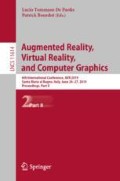Abstract
Previous studies have shown that CVR can promote users’ knowledge acquisition, meaning understanding and emotional experience. This study demonstrates the feasibility and advantages of CVR in intercultural communication through empirical research. A virtual reality video about Japanese shrine culture was produced by shooting and editing, and a Chinese user was selected for a controlled experiment. It turns out that CVR can create an immersive cultural environment for users in intercultural communication and bring a good cultural experience, but it also has some shortcomings that need to be continuously improved through technical means.
Access this chapter
Tax calculation will be finalised at checkout
Purchases are for personal use only
References
MacQuarrie, A., Steed, A.: Cinematic virtual reality: evaluating the effect of display type on the viewing experience for panoramic video. In: 2017 IEEE Virtual Reality (VR), pp. 45–54. IEEE, March 2017
Cheng, A., Yang, L., Andersen, E.: Teaching language and culture with a virtual reality game. In: Proceedings of the 2017 CHI Conference on Human Factors in Computing Systems, pp. 541–549. ACM, May 2017
Passig, D., Eden, S., Rosenbaum, V.: The impact of virtual reality on parents’ awareness of cognitive perceptions of a dyslectic child. Educ. Inf. Technol. 13(4), 329 (2008)
Terlutter, R., Diehl, S., Koinig, I., Waiguny, M.: Who gains, who loses? Recall and recognition of brand placements in 2D, 3D and 4D movies (2013)
Craik, F.I.: Levels of processing: past, present… and future? Memory 10(5–6), 305–318 (2002)
Sato, S., Kageto, M.: The use of 360-degree movies to facilitate students’ reflection on learning experiences. In: 2018 International Symposium on Educational Technology (ISET), pp. 266–267. IEEE, July 2018
Yoganathan, S., Finch, D.A., Parkin, E., Pollard, J.: 360 virtual reality video for the acquisition of knot tying skills: a randomised controlled trial. Int. J. Surg. 54, 24–27 (2018)
Ding, N., Zhou, W., Fung, A.Y.: Emotional effect of cinematic VR compared with traditional 2D film. Telematics Inform. 35(6), 1572–1579 (2018)
Keen, S.: A theory of narrative empathy. Narrative 14(3), 207–236 (2006)
Passig, D., Eden, S., Heled, M.: The impact of Virtual Reality on the awareness of teenagers to social and emotional experiences of immigrant classmates. Educ. Inf. Technol. 12(4), 267–280 (2007)
Author information
Authors and Affiliations
Corresponding authors
Editor information
Editors and Affiliations
Rights and permissions
Copyright information
© 2019 Springer Nature Switzerland AG
About this paper
Cite this paper
Li, Y., Zhang, Y., Chin, M. (2019). Intercultural Communication Research Based on CVR: An Empirical Study of Chinese Users of CVR About Japanese Shrine Culture. In: De Paolis, L., Bourdot, P. (eds) Augmented Reality, Virtual Reality, and Computer Graphics. AVR 2019. Lecture Notes in Computer Science(), vol 11614. Springer, Cham. https://doi.org/10.1007/978-3-030-25999-0_24
Download citation
DOI: https://doi.org/10.1007/978-3-030-25999-0_24
Published:
Publisher Name: Springer, Cham
Print ISBN: 978-3-030-25998-3
Online ISBN: 978-3-030-25999-0
eBook Packages: Computer ScienceComputer Science (R0)

